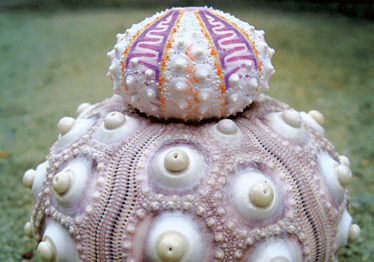Biomimetic Protection of Biomolecules
Porous shells – inspired by sea urchins – help defend biomacromolecules from the outside world

Vaccines and other biomedicines can easily be denatured or decomposed by unforgiving conditions. But does nature already have the answer for protecting at-risk biological material? Well, many organisms collect and process minerals to fabricate tissues that serve structural or functional purposes, and Australian scientists believe that the process of biominerialization can be used to protect biomolecules. Starting out with some preliminary experiments, researchers from Australia’s Commonwealth Scientific and Industrial Research Organization (CSIRO) added proteins to an aqueous solution containing the chemicals needed to produce synthetic porous shells (1).
“Firstly, we investigated the chemical reaction to determine the best ‘biomineralization’ conditions for the production of the porous shells. It was surprising to see that biomacromolecules were acting like micro-reactors, bringing ligands and cations (the precursors of the porous shell) together. The conditions were enough to trigger the formation of a tri-dimensional porous hybrid network, also called a metal-organic framework. Next, we investigated the generality of the method, and discovered that the vast majority of biomolecules were triggering the formation of shells within a few minutes,” says Paolo Falcaro, a researcher in material engineering at CSIRO.
Subsequently, the team studied the properties of the protected system by exposing the encapsulated biomolecules to extreme conditions such as boiling organic solvents and high temperatures. The result? The shells prevented deformation and decomposition that would almost certainly result in loss of bioactivity. In addition to the potential ability to preserve and deliver proteins, antibodies, vaccines, DNA and enzymes, Falcaro believes that the method could open up a new world of applications for biomolecules in chemical processing and biostorage.
“It was fascinating learning that useful natural biomacromolecules were acting like a living entity, bringing together chemicals and generating a self-protective crystalline porous shell,” says Falcaro. “Interestingly, the shell is porous and allows small molecules to diffuse through it. The shell can be dissolved on demand by adding a weakly acid solution.”
How is the shell made? Easy, says Falcaro – akin to preparing instant coffee. The addition of two chemicals (Zn2+ ions and 2-methylimidazole) to an aqueous solution that contains the biomolecules is enough to promote the formation of the protective porous shells.
At the moment, the shells can be prepared only with certain organic ligands and metal ions. “From the chemistry perspective, we are currently investigating other ligands in order to tailor the pore size and topology. From the biochemistry perspective, we are trying to predict the ‘biomineralization’ efficiency of proteins with different hydrophobic/hydrophilic domains and surface charge,” says Falcaro. “We are also investigating the efficacy of the shell for different biological systems.”
- K. Liang et al., “Biomimetic Mineralization of Metal-Organic Frameworks as Protective Coatings for Biomacromolecules,” Nature Communications (2015), doi: 10.1038/ncomms8240.

Making great scientific magazines isn’t just about delivering knowledge and high quality content; it’s also about packaging these in the right words to ensure that someone is truly inspired by a topic. My passion is ensuring that our authors’ expertise is presented as a seamless and enjoyable reading experience, whether in print, in digital or on social media. I’ve spent fourteen years writing and editing features for scientific and manufacturing publications, and in making this content engaging and accessible without sacrificing its scientific integrity. There is nothing better than a magazine with great content that feels great to read.



















